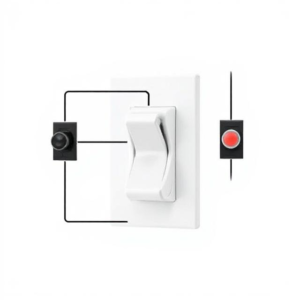What is a High-Voltage Transistor?
A high-voltage transistor is a type of transistor that is specifically designed to handle higher voltages than standard transistors. Transistors are electrical components that act like switches or amplifiers for electrical signals, and high-voltage transistors can control or switch higher amounts of voltage without getting damaged.

What is a Transistor?
First, let’s quickly remind you what a transistor is. A transistor is a tiny electronic device that can either amplify or switch electrical signals. It’s like a gate that can open or close to allow current to flow, and it plays a big role in many electronic devices.
Why Do We Need High-Voltage Transistors?
In many electronic systems, you might need to control or switch signals that carry high voltage (over 30 volts or more), such as those in:
- Power supplies (used in computers or other devices).
- Electric vehicles (EVs).
- Industrial machinery (motors, welding equipment).
- Communication systems (radio towers, satellite equipment).
Normal transistors might not be able to handle these high voltages safely. That’s where high-voltage transistors come in—they are specifically designed to work with larger voltages and are built to avoid damage or malfunction under those conditions.
Key Features of High-Voltage Transistors:
- Higher Voltage Tolerance:
- High-voltage transistors can handle much higher voltage levels than regular transistors. For example, a standard transistor might work at around 30 volts, while a high-voltage transistor might work at hundreds of volts—some can even handle thousands of volts.
- Material:
- To handle high voltages, these transistors are usually made of special materials (like silicon carbide or gallium nitride) that have better resistance to heat and electrical stress compared to regular materials like silicon.
- Durability:
- High-voltage transistors are built to withstand extreme conditions without breaking down, making them perfect for heavy-duty applications.
- Switching Speed:
- Some high-voltage transistors are designed to switch on and off quickly, which is important for high-efficiency power systems or high-speed communication equipment.
How Do High-Voltage Transistors Work?
High-voltage transistors work just like regular transistors, but they are built to manage higher voltages:
- In an amplifier: High-voltage transistors take a weak electrical signal and increase its strength. They can amplify signals with a high voltage, making them ideal for audio equipment or broadcasting.
- In a switch: They control whether or not a current can pass through a circuit. If a circuit requires switching high-voltage signals (for example, in an electric car motor), the transistor opens and closes like a gate.
Types of High-Voltage Transistors:
- BJT (Bipolar Junction Transistor):
- How it works: It has three parts (collector, base, emitter) and controls current between the collector and emitter with a small current at the base.
- Application: BJTs are often used in power electronics and can be used for high-voltage switching, like in power supplies and audio amplifiers.
- MOSFET (Metal-Oxide-Semiconductor Field-Effect Transistor):
- How it works: A MOSFET controls current with an electric field and is widely used in digital circuits. High-voltage MOSFETs have a special design that allows them to handle higher voltages without damage.
- Application: MOSFETs are used in power supplies, motor control systems, and electric vehicles, where high-voltage switching is needed.
- IGBT (Insulated-Gate Bipolar Transistor):
- How it works: An IGBT combines the advantages of both MOSFETs and BJTs. It has the fast switching capabilities of a MOSFET and the high current handling of a BJT, making it perfect for high-power applications.
- Application: IGBTs are used in inverters (like for solar panels), motor drives, and industrial machinery, where high-voltage and high-current control is needed.
Applications of High-Voltage Transistors:
- Power Electronics:
- High-voltage transistors are used in power supplies that provide electricity to large machines, home appliances, and computers. They help convert high-voltage AC (alternating current) into low-voltage DC (direct current) or the other way around.
- Electric Vehicles (EVs):
- In electric vehicles, high-voltage transistors are used to control the flow of electricity to the motor. They handle the high voltage from the battery and ensure the electric motor runs smoothly.
- Industrial Equipment:
- High-voltage transistors are also used in industrial machines (like robots, motors, and welding machines) to safely control large amounts of power.
- Renewable Energy (Solar Inverters):
- Solar power systems use high-voltage transistors in inverters, which convert the DC electricity generated by solar panels into AC electricity for use in homes or businesses.
- Communication Systems:
- High-voltage transistors can amplify signals in communication equipment like radio towers or satellite dishes, where signals may need to be boosted over long distances.
Why Are High-Voltage Transistors Important?
- Safety: High-voltage transistors are designed to safely handle large amounts of power, protecting circuits from damage and preventing accidents.
- Efficiency: They help ensure systems, like power supplies or motors, run efficiently without wasting too much energy.
- Reliability: These transistors last longer and operate more reliably in high-power environments, reducing the chance of failure.
Summary:
- High-voltage transistors are specially designed transistors that can handle large voltages, often in the hundreds or thousands of volts.
- They are used in applications like power supplies, electric vehicles, industrial equipment, and communication systems, where high voltages need to be controlled safely.
- There are different types of high-voltage transistors, such as BJTs, MOSFETs, and IGBTs, each suited for different tasks.
- These transistors are built with durable materials and special designs to protect circuits and ensure safe and efficient operation.
In short, high-voltage transistors act like safety switches or power controllers, enabling efficient and safe handling of large electrical currents in various advanced technologies.











